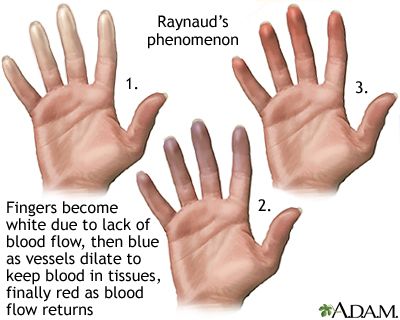Raynaud's Disease

What is Raynaud's Disease?
Raynaud's Disease, sometimes simply referred to as Raynaud's, is a relatively rare disorder of the blood vessels. This condition typically affects the blood vessels in the fingers and toes, but it can also impact other areas such as the nose, lips, ears, and nipples. It is characterized by smaller arteries that supply blood to your skin constricting excessively in response to cold or stress, thus narrowing down and limiting blood circulation to the affected areas.
Who’s at Risk for Raynaud's Disease?
While anyone can develop Raynaud's, it's more common in women than in men. The disease often appears between the ages of 15 and 30. Individuals living in colder climates are at a higher risk due to increased exposure to cold temperatures, a known trigger for the disease. Furthermore, a family history of Raynaud's can also increase an individual's risk.
What Causes Raynaud's Disease?
The exact cause of Raynaud's disease remains unknown. The primary form, known as primary Raynaud's or Raynaud's disease, appears to develop on its own. The secondary form, called secondary Raynaud's or Raynaud's phenomenon, is associated with underlying diseases or conditions like scleroderma or lupus.
The narrowing of blood vessels during an attack is usually triggered by cold temperatures or emotional stress. This reaction is more severe in people with Raynaud's, reducing the supply of blood to the affected areas significantly.
How Does Raynaud's Disease Start?
An episode of Raynaud's disease usually begins with a change in color of the affected areas in response to cold temperatures or stress. The skin turns white and then blue, and feels cold and numb. As blood flow returns, the areas may turn red and throb, tingle or feel painful.
What Are the Symptoms of Raynaud's Disease?
Symptoms of Raynaud's disease are primarily related to the extremities. These may include:
- Cold fingers or toes
- Color changes in your skin in response to cold or stress
- Numb, prickly feeling or stinging pain upon warming or stress relief
How is Raynaud's Disease Diagnosed?
Doctors usually can diagnose Raynaud's based on a patient's description of symptoms. In some cases, they may perform a test called nailfold capillaroscopy, where they examine the skin at the base of your fingernail under a microscope to look for deformities or enlargement of the tiny blood vessels.
How Can Raynaud's Disease Be Treated?
While there's no cure for Raynaud's, treatments can reduce the number and severity of attacks. Lifestyle changes, such as avoiding triggers like cold temperatures and stress, can often effectively manage symptoms. Medications may be prescribed to help dilate blood vessels and improve circulation.
What Complications May Occur with Raynaud's Disease?
If Raynaud's is severe – which is rare – reduced blood flow can cause sores or tissue death (gangrene). In some cases, Raynaud's may also be a sign of a more serious underlying condition, such as a connective tissue disease.
How Can I Prevent Raynaud's Disease?
Preventing episodes of Raynaud's involves avoiding triggers like cold temperatures and stress. Regular exercise, quitting smoking, and maintaining a healthy diet can improve overall health and reduce the likelihood of triggering an episode.
Long-term Management of Raynaud's Disease
Long-term management involves avoiding triggers and protecting the extremities in cold weather. In some cases, medication may be required, especially if Raynaud's is associated with an underlying condition. Regular check-ups with a healthcare provider are necessary to monitor the condition and adjust treatment plans as necessary.
What is Recent Research Saying About Raynaud's Disease?
Recent research is focused on understanding the causes of Raynaud's and finding more effective treatments. For instance, some studies are exploring the genetic factors involved in the disease and how these could be targeted for treatment. Other research is looking at the role of the nervous system and how it might be involved in the narrowing of blood vessels.
Where Can I Go For More Information on Raynaud's Disease?
For more information on Raynaud's disease, visit reputable health websites like the Mayo Clinic, the American College of Rheumatology, or the National Heart, Lung, and Blood Institute (NHLBI). Other resources include patient advocacy groups like the Raynaud's Association, which provides resources for coping with the disease and connects patients with the latest research and treatment options.
In conclusion, while Raynaud's disease can cause discomfort, it can often be managed effectively through a combination of lifestyle changes, medications, and regular medical care. Always consult with a healthcare provider if you think you may have Raynaud's or if you have any questions or concerns about the condition.

